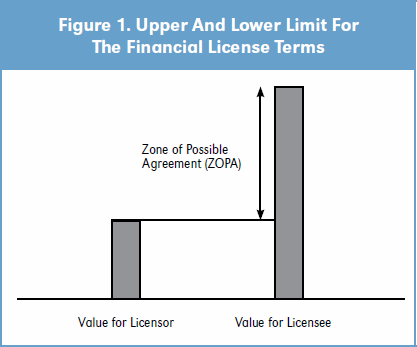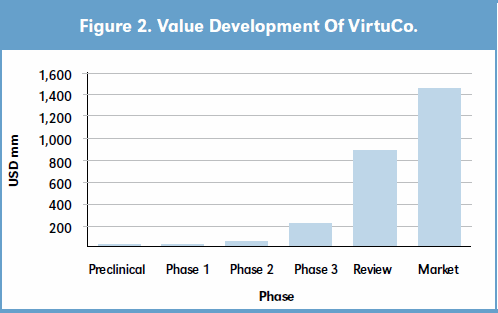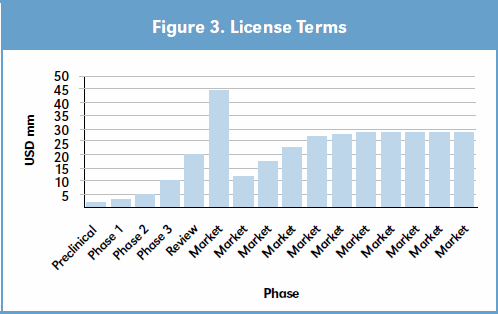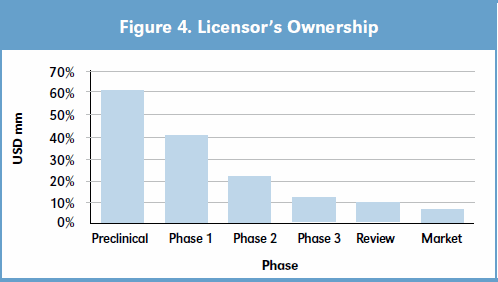How To Determine Fair License Terms: No Need For Rules Of Thumb Anymore
Avance, Basel GmbH
Partner
Basel, Switzerland
An analogy between licensing and corporate investment facilitates the determination of fair license terms and displays whether the deal creates value for both parties. Clumsy and out-of-date rules of thumbs are not needed anymore.
Introduction
Valuation becomes an important issue as soon as it comes down to negotiating license terms. We need to know how much the licensed product is worth and how much we can ask or pay for it. In the licensing community several rules of thumb get applied to determine fair license terms. As an unavoidable consequence these rules of thumb generalize and simplify the actual situation and require adaptation in special cases. When using a rule of thumb for too long its original meaning gets blurred and it develops a life of its own. In this article we revisit the main principle of all business activities, value creation, and deduct a method to determine fair license terms for virtually every industry, free of out-of-date rules and prejudices.
Rules of Thumb Blur the View On Value
Historically, i.e. before the rise of spreadsheet calculations, valuation must have been quite cumbersome. Imagine an R&D project that goes over 30 years from the invention to the end of the life cycle. We need to define R&D investments, sales, COGS, marketing and sales, and G&A expenses for every year. Much of this cash flow actually needs to be deducted from other numbers such as market size, penetration, price, or head count. You then need to possibly risk-adjust and discount the summed up cash flows and add all up to the net present value (NPV). This includes easily 100 calculations, even though most are relatively easy. But imagine that you then want to change some assumptions, or see how a parameter impacts the value. You would have to recalculate many numbers again. The consequences were severe: First, errors were more common, and second, the understanding of the value was weaker because one was simply tempted to do without scenario analysis. In that context some rules of thumb were very useful. Meanwhile, some of these short-cut methods are hardly recognised as such because they have become so common. The price earnings ratio (PE ratio) is one of these short-cuts, just like any sort of multiple-based valuations. With the PE ratio the value becomes a multiple of the annual earnings; there are also revenue ratios, cost ratios, and we have even heard of a value approximation by multiplying a biotech company's head count with US$ 1million (mn). Another famous short-cut is the terminal value. Instead of thinking about the future development of the business activities and how they gradually unfold one simply assumes a steady or even growing annual cash flow and translates it into value. These short-cut methods are very powerful because they allow us to calculate a rough value off the top of our head. But we must not forget that they are only short-cuts, and that the value might also be influenced by other factors, in case of a specific product the short-cuts might actually only yield an unsatisfactory approximation.
In the licensing industry other short-cuts have been popular. The most famous rule is probably the 25% rule that states that the licensor should keep about 25 percent of the value of a product once it's out-licensed (cf. Razgaitis). In les Nouvelles, the 25% rule has already been widely discussed. We only want to point out that the 25% rule again is a shortcut method that might have been valid, if at all, in some industries, for some projects, in some stages of R&D. But it is an acknowledged oversimplification and cannot be generally applied. In the drug development industry evidence shows clearly that the 25% rule is not supported (cf. Borshell and Dawkes). We therefore strongly advocate looking at the roots of the licensing business model and deduct the deal terms starting from the main motivation: value creation. This becomes even stronger an argument considering that nowadays it takes 10 minutes for an experienced spreadsheet user to build up a financial model that can already handle most of the input parameters in a very flexible way. A new scenario can be calculated by simply modifying an input cell. While short-cut methods still prove to be useful when spontaneously discussing some options, they are meanwhile obsolete once it comes to in-depth analysis. Modern tools provide us with that much flexibility that we have no need for any short-cut methods anymore but can appreciate the project in all its details.
A License Deal Must Make Sense For Both Parties
Why do companies license their products? Usually, the answer goes like "it is not our focus to commecialise products," or "we don't have the abilities to do so." But these answers fall short of the main reason. The companies actually could establish a development or commercialization department. They might have to raise money for that step, agreed, but other companies have already done so before them. The reason why they license is in general the universally valid driver for all sound business decisions: it is the more valuable option. First, taking the company from a research lab to a development company or even to a company with a sales force is a major business transformation that comes along with a wide range of costs. Second, the licensee does not have to spend these costs, as it is already an established player. The project is therefore more valuable in the licensee's eyes. Third, an established player might be able to penetrate the market much better than a new, inexperienced company. Again, the project is more valuable in the licensee's hands than in the licensor's. In some cases not all points are checked, but if taking the project to the market were more economically attractive then the licensor would do that. In the case of an academic institution, that has to respect some legal boundaries, this could also happen via a spin-out instead of a license. From the above considerations it becomes already clear that any value share principle should be increasing, i.e. the closer to commercialization, the higher should be the value share, because the licensee has to bear less transformation costs. If the licensor has several projects and can distribute the transformation costs to several projects, then it might start making sense establishing its own commercialization arm. This way the full value of the projects can be exploited instead of only a share of it through license agreements. This is what has happened, e.g., to Genentech, that first licensed its products and then started to commercialise its drugs on its own.
For the licensee the same reasoning applies. As soon as the licensee gets more value than it pays as a price (i.e. the license terms), then the deal makes sense. Or put differently, as soon as the overall deal has a positive value it is better than the alternative of rejecting the deal. Of course, the alternative can also be another deal, or even an in-house project. Usually, we talk about a stage-specific, or risk-adjusted cost of opportunity, i.e. the project must exceed a certain expected rate of return to be considered as valuable. This is exactly the discount rate that leads to the project NPV for the licensee.
Any form of value share model, be it the 25% rule or a stage-specific value share model, fails to explain whether the deal makes sense for the licensor. It certainly does make sense for the licensee—as long as the value is positive, of course—because it can claim 75 percent of the value, while the alternative is 0. For the licensor, on the other hand, it is less obvious that its alternative of taking the project alone to the market is worth less than only 25 percent of the project value in the licensee's hands. For an advanced project that is relatively close to commercialization, or for a company with a larger pipeline the value could easily be better than 25 percent. But in such cases it might still make sense to license for both parties, but obviously to higher terms than suggested by a value share method.
The Licensor Gradually Buys Parts of the Project
One of the more annoying features of any value share method is that it looks as if the licensor leaves some value on the table. Before the license it owns 100 percent of a project that he then out-licenses for only a fraction of that value. Economically this makes no sense. Of course, we talk here about different values, namely 100 percent of the value of the project in the licensor's hands and only a fraction of the value of the project in the licensee's hands. But it would still be nice to have a model that provides
a solid explanation whether a deal is a good option or not. The licensor should pay the full price of the project and not only a share.

For this we imagine that the licensor sets up a company VirtuCo, from virtual company, and puts the project into that company as its own asset. The goal is to sell this company to the licensee at a fair price. A license contract is usually composed of two main types of payments; milestones, including the upfront payment, and royalties. For this model to work it is important that we have a valuation method that can attribute the project a value at each value inflection point. Whether this valuation method is risk-adjusted net present value (rNPV, cf. Bogdan and Villiger), the venture capital method (cf. Sahlman), or anything else doesn't matter, as long as the method provides realistic values compared to what you find in the market place.
Imagine now that the licensee pays an upfront payment to the licensor. For this upfront payment the licensee gets the corresponding amount of shares of VirtuCo in exchange. The licensee now already owns a part of VirtuCo, or the project that is in VirtuCo. The project now needs to be developed in order to take it to the market. This development is usually paid for by the licensee. In our model this means that VirtuCo raises money from the licensee in order to pay for the development costs. With this the licensee increases its stake in VirtuCo by diluting the licensor. After a development phase the project comes to a value inflection point. This means that the value of VirtuCo takes a leap. The next milestone, and the next investment by the licensee takes place at that higher valuation. The purchasing and dilutive power is now already weaker than in the previous phase. This way the licensor keeps selling shares of VirtuCo against milestone payments to the licensee. And the licensor also gets diluted due to the R&D costs borne by the licensee. Once the project is ready to be commercialized the licensor is still left with a small share package in VirtuCo. But now VirtuCo starts making profits. The profits usually get either reinvested, put into reserves, or are paid out to the shareholders as dividends. Since reinvestment and reserves are not an option for a virtual company with only one asset the profits are paid out proportionally to the licensor and the licensee. These payments correspond to the royalties. Of course, royalties are taken from sales, or revenues, and not from profits. The royalty rate therefore corresponds to the licensor's remaining stake in VirtuCo times the ratio of the NPV (at the time of commercialization) of the profits to the NPV of the revenues.
Example
We explain the model with a short example from drug development. We assume a pre-clinical project that still has to go through all clinical development phases. Applying a 20 percent discount rate should ensure that the deal is attractive enough for the licensee; usually a pre-clinical project is discounted at 18 percent - 19 percent (cf. Avance-Biostrat). The assumptions laid out in Tables 1 and 2 correspond to industry data, even though the development plan and especially the sales assumptions need to be adapted for each project.
| Table 1. R&D Assumptions |
| Phase | Preclinical | Phase 1 | Phase 2 | Phase 3 | Review | Market |
| Costs (USD mn) | 3 | 4 | 15 | 75 | 50 | 100 |
| Success Rates | 77% | 77% | 44% | 62% | 85% | |
| Duration (years) | 1.5 | 1.5 | 2.5 | 3.5 | 1.5 | |
| Table 2. Commercialisation And General Assumptions |
| Discount | 20% |
| Peak sales (USD mn) | 700 |
| Patent protected sales (years) | 11 |
| Operating margin | 65% |
Calculating the project value with these assumptions we receive USD 9.8 mn at the start of preclinical phase. This value—the value of VirtuCo—keeps increasing until launch due to the closer distance to launch (less discounting), resolved uncertainty (less risk-adjusting), and already spent expenses.
An upfront payment of USD 2 mn corresponds already to 20.3 percent of the pre-money value of USD 9.8 mn. And with the preclinical costs the licensor gets diluted down to 61.1 percent ownership in VirtuCo. If the project can start Phase 1, then the value of VirtuCo raises to USD 22 mn. The milestone of USD 3 mn earns the licensee another 13.7 percent of VirtuCo. Until launch the licensor's stake gradually decreases either via sale against milestones or due to dilution because of the licensee's R&D investments. At launch finally, the licensor is left with 6.4 percent of VirtuCo. At an ongoing operating margin of 65 percent this corresponds to a royalty rate of 4.1 percent.



The Model Explains Several Traits of the Licensing Business
At first sight it is difficult to differentiate input and output of the model. Having agreed on the assumptions the discount rate determines the value of VirtuCo. For the licensor it is important that this value is greater than the value of the alternative scenario, e.g. taking the product further on its own, or licensing to somebody else. With the determination of the milestones the royalty rate then becomes a function of the licensor's remaining stake and the operating margin. The model displays how high the royalty rate must be such that the licensee indeed purchases VirtuCo at a fair price. On the other hand, given all the license terms, the virtual company model can also indicate the value of the deal. In fact, from the cash flows assumptions and the license terms we can determine the internal rate of return (IRR) of the project (including the license payments) for the licensee. The project cash flows (without the license payments) discounted at this IRR correspond exactly to the value of VirtuCo. This can be easily seen by the fact that the IRR is the discount rate that yields a value of zero. And since for the licensee the whole license deal is a zero value investment—it pays exactly what it gets—this IRR corresponds exactly to VirtuCos discount rate. By choosing a discount rate that is slightly higher than the stage-specific hurdle rate we can make sure that the deal in reality is not a zero value investment for the licensee. It indeed represents value because we have artificially increased the discount rate and with this lowered the value of VirtuCo. While the licensee gets the value that should be calculated with the correct discount rate, it only has to pay the price (i.e. the value of the license terms) that are calculated using a higher discount rate.
The model also explains very nicely why royalty rates should be up-tiered. At first up-tiered royalties don't seem to incentivise the licensee to increase sales performance, because the margin might drop. But in absolute terms, higher sales mean, of course, also higher profits. Much more importantly, imagine that half-way through development it becomes clear that the project is actually better than originally expected. This means that the sales assumptions must be adapted and that the value of VirtuCo increases. With the remaining milestones and R&D investments the licensee cannot increase its stake in VirtuCo as originally forecasted, because VirtuCo is now more valuable and the licensees purchasing and dilution power is relatively smaller. This means that the licensor ends up with a higher stake in VirtuCo at launch. This results directly in a higher royalty rate. Hence, higher sales lead to higher royalties, and lower sales lead to lower royalties.
And finally, the virtual company model provides a clear rationale for the sub-licensing or participation rates. Licensor and licensee can agree that in case the licensee sub-licenses the product the original terms between licensor and licensee get replaced by a share of the new terms between licensee and sub-licensee. As a consequence, all payments after the sub-license correspond to the product's better to judge quality at the point of the sub-license. If the product turns out to be better than originally thought, the terms will be higher. This mechanism is perceived to increase fairness between licensor and licensee, as the original terms often have to be agreed on in an early-stage where several assumptions are of rather speculative nature. The virtual company model indicates exactly what these sublicense rates should be. They correspond to the ownership of the licensor in VirtuCo at the time of the sub-license. These sub-license terms are often the subject of major, even deal-breaking discussions in negotiations. This model now provides a quantification of these terms and directs the negotiation from price to value. Moreover, the model also allows a simple consideration of co-development terms. If both companies plan to contribute to the development, then the licensee is not the sole investor in VirtuCo in a specific phase, but also the licensee participates in these fund raising rounds. And finally this model is versatile enough to consider also special license schemes as, e.g., where the royalties are kept fix and only the milestones get adapted to the sub-license contract. In that case, we would have to consider the royalty value of the licensor in VirtuCo as undilutable, which of course has the consequence that the remaining value is purchased and diluted quicker.
Final remarks
Of course, VirtuCo does not have to be founded; it only serves as a model for the design of the deal terms. It would take way too much administrative work and renegotiation to determine the value at each milestone and R&D investment. We therefore predict these values upfront in the model by valuation. This comes at the expense that the deal terms are nevertheless quite sensitive to crucial assumptions such as sales, margin, probabilities, or discount rate (i.e. starting value for VirtuCo). But this disadvantage is shared with any other valuation-based approach. In addition, the virtual company model equips the user with sound arguments why even complex deal structures such as sub-license terms should be as proposed. This provides the user with confidence while navigating through various term sheets.
References
Avance, Biostrat, "Survey about discount rates," 2010.
Bogdan, Boris and Villiger, Ralph, "Valuation in Life Sciences. A Practical Guide," 3rd edition, Springer Verlag, 2010.
Borshell, Nigel and Dawkes, Adrian, "Pharmaceutical Royalties in Licensing Deals: No Place for the 25% Rule of Thumb," white paper, PharmaVentures.
Razgaitis, Richard, "Valuation and Pricing of Technology-Based Intellectual Property," Wiley, 2003.
Sahlman, William A., "A Method for Valuing High-Risk, Long-Term Investments—The 'Venture Capital Method'," Harvard Business School, Rev August 12, 2003.